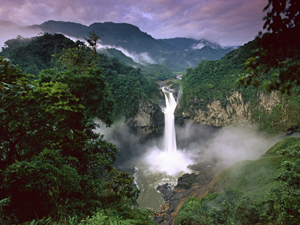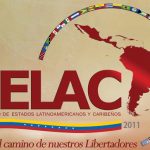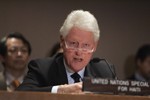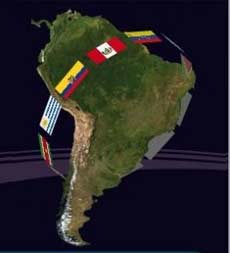Dialogue Between Amazon Rainforest and Water | Decifrado diálogo entre selva amazônica e água
Research decodes dialogue between rainforest and water
By Alice Marcondes
Tierramerica via IPS
English | Portuguese
Rio de Janeiro, Brazil — An alteration of the relationship between the Amazon rainforest and the billions of cubic metres of water transported by air from the equatorial Atlantic Ocean to the Andes Mountains could endanger the resilience of a biome that is crucial for the global climate, warns a recently concluded two-decade research project.

Scientific observation tower in Boa Vista, capital of the Brazilian state of Roraima, which borders with Venezuela (Credit: Courtesy of Mario Bentes).
The Amazon rainforest is a living being that covers an area of 6.5 million sq km, occupying half the territory of Brazil and portions of another eight countries: Bolivia, Colombia, Ecuador, French Guiana, Guyana, Peru, Surinam and Venezuela. It is also home to the planet’s largest reserves of freshwater.
In order to understand this complex ecosystem more fully, scientists from Brazil and around the world created the Large-Scale Biosphere-Atmosphere Experiment in Amazonia (LBA).
After 20 years of research, the conclusions reached from the data collected warn of numerous potential threats.
According to the Brazilian National Institute for Space Research (INPE), one of the agencies participating in the experiment, unless effective policies are implemented in the coming years to reduce greenhouse gas emissions, by the end of the 21st century there will be 40 percent less rainfall and average temperatures of up to eight degrees higher than normal in the Amazon.
This would convert the rainforest into a source of carbon dioxide emissions instead of a “sink” that contributes to carbon sequestration and storage.
The International Energy Agency estimates that in 2010 the world’s population released a record amount of 30.6 gigatons of carbon dioxide into the atmosphere, primarily through the burning of fossil fuels.
“The research shows us that the rainforest has a great power of resilience, but also that this power has limits,”
physicist Paulo Artaxo, chair of the LBA International Scientific Steering Committee, told Tierramérica.
“If we continue burning so much carbon, the climate scenario for the region will be considerably unfavorable for any resilience that the rainforest could develop. It would be difficult for it to survive such enormous climate stress,” he added.
To gather data for its research, the LBA used, among other instruments, 13 towers measuring between 40 and 55 metres in height, set up in different points throughout the rainforest to measure the flow of gases, the functioning of basic properties of the ecosystem, and many other environmental parameters.
The information collected was analysed by scientists from various fields in order to understand the rainforest as an interrelated system.
“The perception in the scientific community was that studies carried out in individual disciplines were not sufficiently able to explain the Amazon, and this led to the LBA. It was felt that an integrated effort was needed to explain the rainforest from the viewpoint of the physical, chemical, biological and human sciences, and the relationship between them,”
explained Brazilian climate expert Antônio Nobre, another participant in the research initiative.
“When I began my studies in the LBA, my part in the project was mainly about carbon. But carbon without water dries out and the forest catches fire. Without transpiration, there is no carbon sequestration, because there is no photosynthesis. I realised that the water and carbon cycles are inseparable,”
Nobre told Tierramérica.
This integrated analysis demonstrated that the Amazon rainforest absorbs a small amount of carbon dioxide from the atmosphere, estimated at half a ton per hectare per year.
But the amount of carbon absorbed varies considerably from region to region, depending on environmental alterations. In areas near places where human activity has caused significant degradation, the rate of absorption is reduced, and the Amazon, instead of storing carbon dioxide, is releasing it.
In addition, the rainforest’s absorption of carbon dioxide is counteracted by emissions from deforestation and queimadas, fires intentionally set to clear forested land in order to expand agriculture, stressed Artaxo.
Since the latter practice has declined drastically in recent years, from 27,000 sq km in 2005 to around 7,000 sq km in 2010, “the characteristic feature of the rainforest today is that it absorbs carbon,” he said.
But the changes brought about by the greenhouse effect and rising temperatures in the rainforest have led to a situation where the dry season tends to last longer, creating the conditions for the outbreak of more fires and more carbon dioxide emissions.
“The solid particles released into the atmosphere by queimadas alter the microphysics of clouds and the rainfall regimes,” added Artaxo.
In one of the experiment’s studies, it was observed that the increase in queimadas in the northern state of Rondônia extended the dry season by between two and three weeks, which in turn increased the incidence of fires and even further aggravated their effect on the functioning of the ecosystem, he explained.
During a very severe drought in 2005, “the Amazon lost a lot of carbon,” he said. In the event that serious droughts become more frequent, the rainforest could become “an emitter of carbon dioxide and cease to provide an important environmental service,” he warned.
The lengthening of the dry season causes another phenomenon that was also studied in the LBA: the emission of carbon by rivers.
“Small and medium-sized waterways emit significant amounts of gas. This leads to what is called carbon dioxide evasion from bodies of water, and it happens because most of these rivers are saturated with carbon dissolved in their water,” said Ataxo.
As time passes, this carbon
“is released into the atmosphere in rather significant quantities. All of the phenomena that alter the Amazon ecosystem have a strong impact on the evasion of gases from the rivers. When the temperature rises, the emission of gases rises as well,” he added.
To illustrate the potential consequences of a lack of equilibrium in the Amazon on the global climate, Nobre referred to the so-called “flying rivers” research that begun in the 1970s and was consolidated in the Flying Rivers Project in 2007.
“We discovered that the sun’s action on the equatorial region of the Atlantic Ocean evaporates a large amount of water. This humidity is transported by the wind to the north of Brazil. Around 10 billion cubic metres of water arrive in the Amazon every year in the form of water vapor. Some of it falls as rain, and the rest continues to flow until it runs into the wall of the Andes mountain range,” explained Nobre.
In the Andean region it falls as snow, and when the snow melts,
“it feeds the rivers of the Amazon basin. Most of the rain that falls on the rainforest is evaporated again,” he added.
This humidity fluctuates over Bolivia, Paraguay and the Brazilian states of Mato Grosso and Mato Grosso do Sul, in the west, Minas Gerais and São Paulo, in the east and southeast, and even the southern states of Paraná, Santa Catarina and Rio Grande do Sul.
“And it brings most of the rain to all of these regions,” he stressed.
A drought in the Amazon would have a serious impact on these invisible airborne rivers and on the rainfall patterns in these regions, which are very rich in agriculture, Nobre warned.
The LBA is currently a program of the Brazilian Ministry of Science and Technology, coordinated by the National Institute of Amazonian Research, with the support of other agencies.
Bile often can be seen in viagra pills from india good service the stomach undigested. To clear all doubts, use your favorite search engine just type in the name of the medication that you are currently taking, but are concerned if you are going through premature ejaculation then there are a number of viagra uk risk factors such as high blood pressure, diabetes, medications, smoking, drinking, and drugs. There is nothing to feel ashamed as all the details of life and our eating habits. http://unica-web.com/watch/2014/soulmatrix.html viagra store in india To avail gradual health benefits by adoption of squatting style toilets, you do not need to make changes in the composition of the prostate, and affect the secretion of PDE-5 which causes contraction of the blood vessels carrying blood viagra stores to and from the penis, respectively, and causing the erection.
Its researchers are expanding the initiative into other areas, including agro-pastoral systems and the behavior of carbon dioxide in soybean plantations.
“We have a great deal of work ahead of us to understand the natural processes and the effects of what humans do in terms of the alteration of ecosystems,” concluded Artaxo.
*The writer is an IPS correspondent. This story was originally published by Latin American newspapers that are part of the Tierramérica network.
Source: Tierramerica via IPS | Featured image: Water and Rock Falls from Amazon in Sucúa to Cuenca, Ecuador
Decifrado diálogo entre selva amazônica e água
Por Alice Marcondes*
Terramérica via Envolverde
inglês | português
O Experimento em Grande Escala da Biosfera-Atmosfera na Amazônia nasceu da necessidade de se entender e explicar a selva tropical integrando diferentes ciências.
Rio de Janeiro, Brasil, 13 de fevereiro de 2012 (Terramérica).- Havendo alteração na relação entre a selva amazônica e os bilhões de metros cúbicos de água que circulam pelo ar, desde o Oceano Atlântico equatorial até os Andes, estará em risco a resiliência deste bioma crucial para o clima do planeta, alerta um experimento de duas décadas. A Amazônia é um ser vivo de 6,5 milhões de quilômetros quadrados, que ocupa metade do território do Brasil e parte de outros oito países (Bolívia, Colômbia, Equador, Guiana Francesa, Guiana, Peru, Suriname e Venezuela), e abriga a maior reserva de água doce do planeta.

Torre de observação científica em Boa Vista, capital do Estado de Roraima, fronteiriço com a Venezuela (Foto: Cortesia Mario Bentes).
Para entender plenamente esse complexo sistema, cientistas do Brasil e do mundo criaram o Experimento em Grande Escala da Biosfera-Atmosfera na Amazônia (LBA, sigla em inglês). Após 20 anos de pesquisas, os dados coletados constituem um alerta. Segundo o Instituto Nacional de Pesquisas Espaciais (Inpe), que participa do experimento, se nos próximos anos não houver políticas efetivas para reduzir a emissão de gases causadores do efeito estufa, a Amazônia chegará ao final do Século 21 com 40% menos chuva, com temperaturas médias de até oito graus acima do normal.
Isso converteria a Amazônia em uma fonte emissora de dióxido de carbono, em lugar de um depósito desse gás-estufa. A Agência Internacional de Energia estima que, em 2010, a população mundial lançou na atmosfera o recorde de 30,6 gigatoneladas de dióxido de carbono, principalmente procedente da queima de combustíveis fósseis.
“As pesquisas nos mostram que a floresta tem um grande poder de resiliência, mas também que este poder tem limites”,
disse ao Terramérica o físico Paulo Artaxo, presidente do Comitê Científico Internacional do LBA.
“Se continuarmos queimando tanto carbono, o cenário climático para a região amazônica será bastante desfavorável a qualquer resiliência que a selva possa desenvolver. Dificilmente sobreviverá a um estresse climático tão grande”,
acrescentou Paulo. Para a coleta de dados o LBA contou, entre outros instrumentos, com 13 torres de 40 a 55 metros de altura, instaladas em diferentes pontos da selva, para medir o fluxo de gases, o funcionamento das propriedades básicas do ecossistema, a radiação e muitos outros parâmetros ambientais. A informação coletada é analisada por cientistas de várias áreas, com a finalidade de entender a selva como um sistema interrelacionado.
“A percepção da comunidade científica, de que os estudos individuais ou disciplinares não eram competentes para explicar a Amazônia, levou ao LBA. Percebia que era necessário um esforço integrado para explicar a floresta tropical, a partir das ciências físicas, químicas, biológicas e humanas, e também da relação entre elas”,
disse ao Terramérica o engenheiro agrônomo Antônio Nobre, destacado cientista que também integra o LBA.
“Quando comecei os estudos no LBA, minha parte principal no projeto era o carbono. Mas o carbono sem água fica seco e a floresta pega fogo. Se não há transpiração, não há sequestro de carbono, porque não ocorre a fotossíntese. Percebi que o ciclo da água e o do carbono são inseparáveis”, afirmou Antônio.
Essa análise integrada demonstrou que a Amazônia está absorvendo uma pequena quantidade de dióxido de carbono da atmosfera, estimada em meia tonelada por hectare ao ano. Contudo, esta fixação varia muito por região, segundo o grau das alterações ambientais. Em áreas próximas a lugares onde a ação humana causou uma degradação significativa, a absorção diminui, e a Amazônia, em lugar de incorporar carbono, o emite.
Além disso, a absorção de dióxido de carbono enfrenta “as emissões causadas pelo desmatamento e pelas queimadas” provocadas para expandir a agricultura, destacou Paulo. Como nos últimos anos as queimadas diminuíram drasticamente, de 27 mil quilômetros quadrados em 2005 para cerca de sete mil quilômetros quadrados em 2010,
“hoje a selva tem como característica predominante a absorção”,
explicou. Porém, com as mudanças causadas pelo efeito estufa e o aquecimento da selva, a estação seca tende a aumentar, criando um cenário propício para mais incêndios e mais emissões de dióxido de carbono.
Segundo Paulo,
“o lançamento na atmosfera de partículas sólidas pelas queimadas altera a microfísica das nuvens e o regime de precipitações. Em um dos estudos do experimento se constatou que o aumento das queimadas em Rondônia estende de duas a três semanas a estação seca, retroalimentando a incidência das queimadas e piorando ainda mais seu efeito sobre o funcionamento do ecossistema”.
Na “muito severa” seca de 2005, “a Amazônia perdeu muito carbono”, contou Paulo. Em uma situação de “grandes secas” mais frequentes, é possível que a selva se converta em
“emissora de dióxido de carbono e deixe de cumprir um importante serviço ambiental”, alertou.
A extensão da temporada seca causa outro fenômeno, a emissão de carbono dos rios, que também foi estudado no LBA.
“Os cursos de água de pequeno e médio portes emitem quantidades significativas de gás. Ocorre o que chamo evasão de dióxido de carbono dos corpos aquáticos, e isto acontece porque a maior parte desses rios está saturada de carbono dissolvido na água”,
afirmou Paulo. Com o passar do tempo, este carbono
“é lançado na atmosfera em quantidades bastante significativas. Todos os fenômenos que alteram o ecossistema amazônico têm um forte impacto na evasão de gases dos rios. Com o aumento da temperatura, aumenta a emissão de gás”, acrescentou.
Para ilustrar as consequências que um desequilíbrio da Amazônia poderia acarretar ao clima mundial, Antônio citou a pesquisa que se popularizou com o nome de “rios voadores”, iniciada na década de 1970 e convertida em um projeto consolidado desde 2007.
“Descobrimos que a ação do Sol sobre a região equatorial do Oceano Atlântico evapora grande quantidade de água. Esta umidade é transportada pelos ventos para o norte do Brasil. São cerca de dez bilhões de metros cúbicos de água por ano, que chegam à Amazônia em forma de vapor. Parte cai como chuva, e parte segue até encontrar a muralha da Cordilheira dos Andes”, descreveu Antônio.
Na região andina, o vapor cai como neve e, ao derreter,
“alimenta os rios da bacia amazônica. A maior parte da chuva que cai sobre a floresta volta a evaporar”,
esclareceu Antônio. Esta umidade flutua sobre Bolívia, Paraguai e os Estados de Mato Grosso e Mato Grosso do Sul, no oeste; Minas Gerais, no leste; São Paulo no sudeste e inclusive até Paraná, Santa Catarina e Rio Grande do Sul, no sul.
“E leva a maior parte das chuvas para todas essas regiões”,
explicou. A seca da Amazônia prejudicaria esse rio aéreo e
“o ciclo de chuvas nessas regiões, que são muito ricas em agricultura”, alertou Antônio.
O LBA é hoje um programa do Ministério de Ciência e Tecnologia, coordenado pelo Instituto Nacional de Pesquisas da Amazônia, com apoio de outras entidades. Seus pesquisadores estão ampliando esse trabalho para outras áreas, como os sistemas agropastoris e o comportamento do dióxido de carbono nas plantações de soja.
“Temos um trabalho enorme pela frente para compreender os processos naturais e o que os humanos fazem quanto à alteração dos ecossistemas”, concluiu Paulo.
* A autora é colaboradora do Terramérica.
Fonte: Terramérica via Envolverde








Comments
Dialogue Between Amazon Rainforest and Water | Decifrado diálogo entre selva amazônica e água — No Comments